Ok, now this is getting ridiculous.
Theme Song from: LG Dryer Cycle Complete
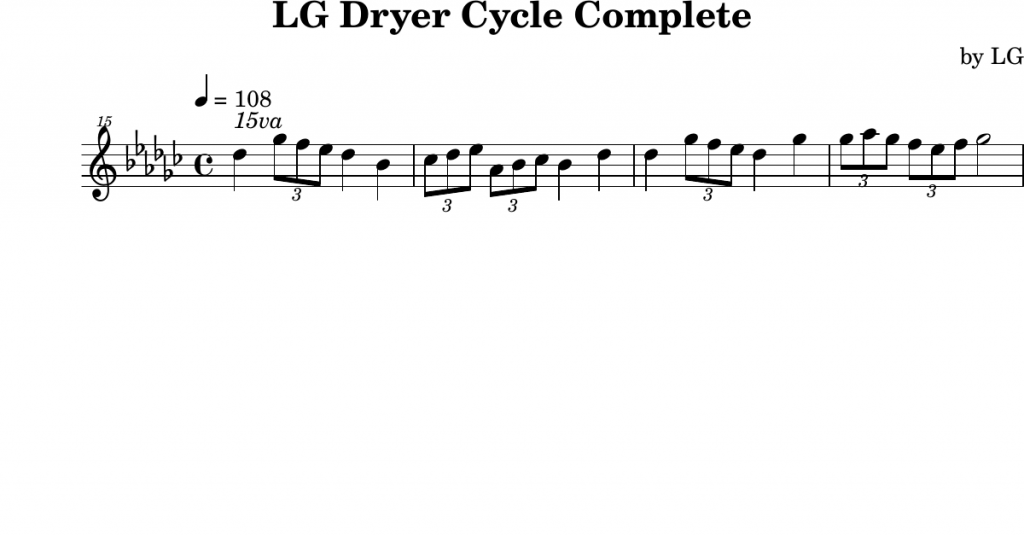
Eubie Blake composed the Baltimore Todolo in 1910.
I spent over 40 hours painstakingly transcribing this ragtime classic into LilyPond source code, without having viewed or referenced any other existing transcription. The idea was to generate sheet music that accurately represents the music exactly as played, as opposed to someone’s own approximate version of it. It’s gratifying to be able to play it just like Blake, complete with most of the proper timing and dynamics. It gives insight into the thought process and piano technique that makes his style unique, even clarifying some of the finger and hand motions he must have used.
When transcribing, it’s often difficult deciphering which notes are being played, especially in chords during noisy sections of music. This kind of transcription would not be possible without software like “Transcribe!” which performs a frequency analysis and allows the music to be played at speeds ranging from normal to very slow, without frequency shift – but also allows a frequency shift when it’s useful to better hear lower or higher notes. I often end up repeating a single chord for minutes on end while trying to reproduce the notes on my nearby piano keyboard until the right combination suddenly clicks in an “aha” moment.
In some cases it might appear a composer playing his own composition has made a “mistake.” However, one could reasonably argue that that’s not possible, especially since he never plays it the same way twice. For this reason I reproduce most of the oddities in the recording. Some of them include measure 8 (G+A), 56 (B-flat strike indicates probably played RH only), 67 (final F octave slid onto G), 82 (played even weirder than this), 84 (pounding almost indecipherable), 90 (the 2nd high D is played nearly as C, tied with the following C), 93 (he slides the 4th finger many times in Charleston Rag), 94 (odd RH), 96 (missing D-flat in LH).
Blake is often heard shouting phrases during live performances. Those are included for fun; I think I’ve got them right.
Like much ragtime music, this piece is to be “swung,” meaning that pairs of 8th notes are to be played more like triplet 8th notes, where an 8th rest is added in the middle of each pair. I note this at the beginning of the piece, then present the whole piece using plain 8th notes. I also have LilyPond add swing during MIDI generation. This method of writing swung music using plain 8ths is much preferable to what some transcribers do, which is to use a dotted 8th and a 16th. Besides resulting in a messy score, the rhythm is just wrong. The overly-pronounced swing irretrievably ruins the MIDI output. In this piece, the magnitude of the swing varies from considerable to barely detectable. I’ve tried to notate that using an asterisk for straight 8ths. There isn’t any standardized notation for that, other than by writing out the words straight eighths, which is overkill when just a few notes need to be straight, and frequently so.
The source recording I used was released by Columbia Records in 1969 and was made available on YouTube. I could only find this one version, unlike the Charleston Rag, which has a piano roll and at least three recorded performances by Blake himself. In the case of the Charleston Rag, my transcription is mostly accurate to a recording in 1972, but I also incorporated some details from an early piano roll that found more enjoyable to play.
Here is a cover page I designed using GIMP (the open source GNU image editor similar to Photoshop).
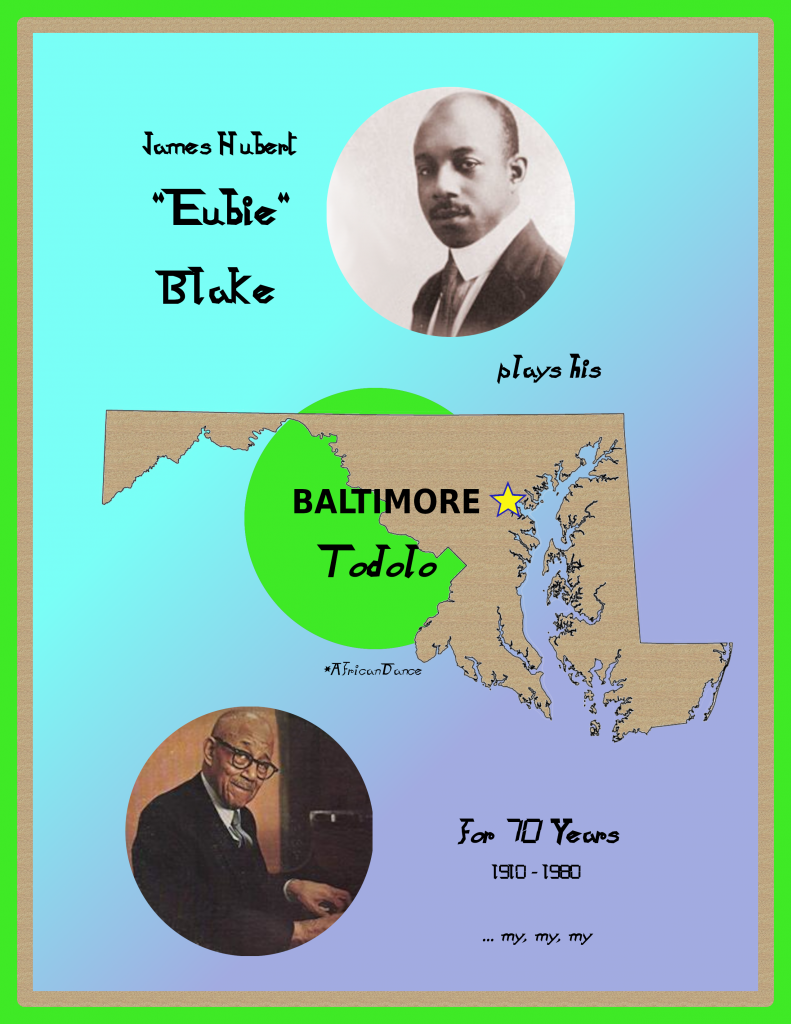
And here is a PDF of my transcription (4 pages):
Here is a MIDI file for download, and also an on-line MIDI player for instant gratification. This barebones MIDI player doesn’t do it justice, so I’d recommend downloading the MIDI and playing through a better program. LilyPond’s MIDI output is pretty good when using the “articulate” module. I also use a module that generates the swing (swing.scm), which I’ve further customized to exclude the small sections that are to be rendered as straight eighths.
The Charleston Rag originally went by other names such as “Sounds of Africa”. Eubie Blake composed this in 1899 while in his early teens. It didn’t get written down until as late as 1917 when it was also made into piano rolls.
Terry Waldo, a student of Eubie Blake, wrote a transcription in 1972 when Blake was in his 90s. Other publicly available sheet music is not of very high quality, so I determined to edit and typeset a version here. I referenced several sources for this:
First, a sheet music cover image that I created using Bing Generative AI (DALLE-3) and the GIMP image editing tool:
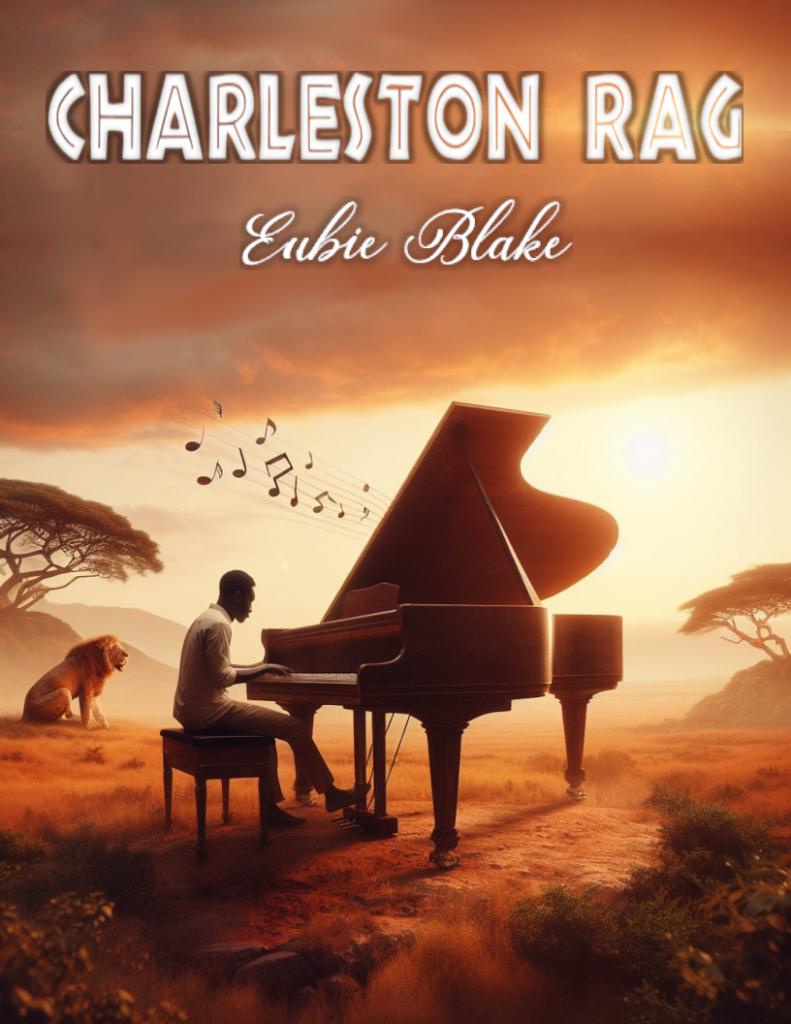
Here is the transcription (6 pages):
Here is the MIDI player and download:
My neighborhood in California is plagued by an ice cream truck that can be heard often from blocks away. Sorry if you have been subject to it. If so, you might want to skip this to avoid psychological trauma.
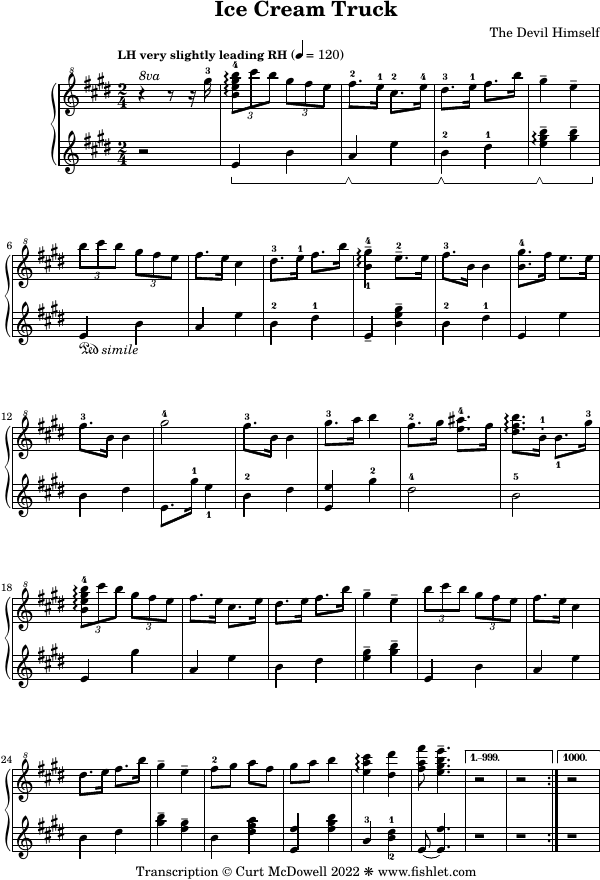
The usual software was used to transcribe (Transcribe!) and typeset (Lilypond) this music. Unfortunately, the MIDI generator in Lilypond does not arpeggiate arpeggios.
In the video below, Art Tatum and his band are warming up at Three Deuces in New York City, Dec 5th 1943. Here is my transcription of it, with piano and bass.
This fun piece from 1912 was made popular by Al Jolson and other performers. It’s from the ragtime era (1900-1920) and is sometimes heard at ragtime festivals.
After seeing a version of this being played on a calliope, I found the original sheet music as published by F. A. Mills in 1912, and re-typeset it with just a few minor changes to improve the MIDI playback. The MIDI instrument “baritone sax” is supposed to mimic a calliope, but falls short.
The recommended tempo is 120 to the quarter note (duration 3:07 if using all repeats).
One thing led to another and I discovered Whitewash Man, a 1908 ragtime piece by Jean Schwartz.
First I saw Neville Dickie performing miscellaneous pieces at the 2018 West Coast Ragtime Festival, and subsequently looked him up on YouTube, where I saw his 2009 performance of The Whitewash Man, with Hal Smith accompanying on drums. This is a truly joyful arrangement by Mr. Dickie that is in a higher register than the original with expert embellishments.
Of course I found and downloaded the sheet music, where the only version to be found was the original publication, which is rather simple and dry (although not entirely trivial to play). I played it a lot and kind of customized my rendition, but have since stopped playing it that way in favor of the Sutton version below. Something close to the original can be seen here on a player piano and is not too exciting:
Further research turned up Ralph Sutton’s extremely jubilant performance, which was published on an album called Carolina in the Morning in January 1949. It can be heard below, and I managed to find a high quality FLAC audio file archived from a 78 record. Amazingly there were less than 90 views of this video in the past 5 years. Let’s fix that!
I wanted to be able to play this version, and decided to try transcribing it. I used the Transcribe! software, but soon gave up. The less-than-great audio quality and the complexity of the piece made it too hard to determine which notes were being played.
Around a year later, I ran across the AnthemScore software that claims to convert audio files into sheet music, and gave it a shot. Success! Although the music output by the program is a real mess, it gave innumerable insights into what the music might be, and then working with Transcribe! I was able to interpret and write down what I think is close to what Mr. Sutton played. This took entirely too much time.
Then I spent far too much time learning to play it at speed. I will try to record my (poor) rendition of this at some point. Here is a cover sheet I designed with the help of the Bing/DALLE-3 AI image generator and the GIMP image editor:
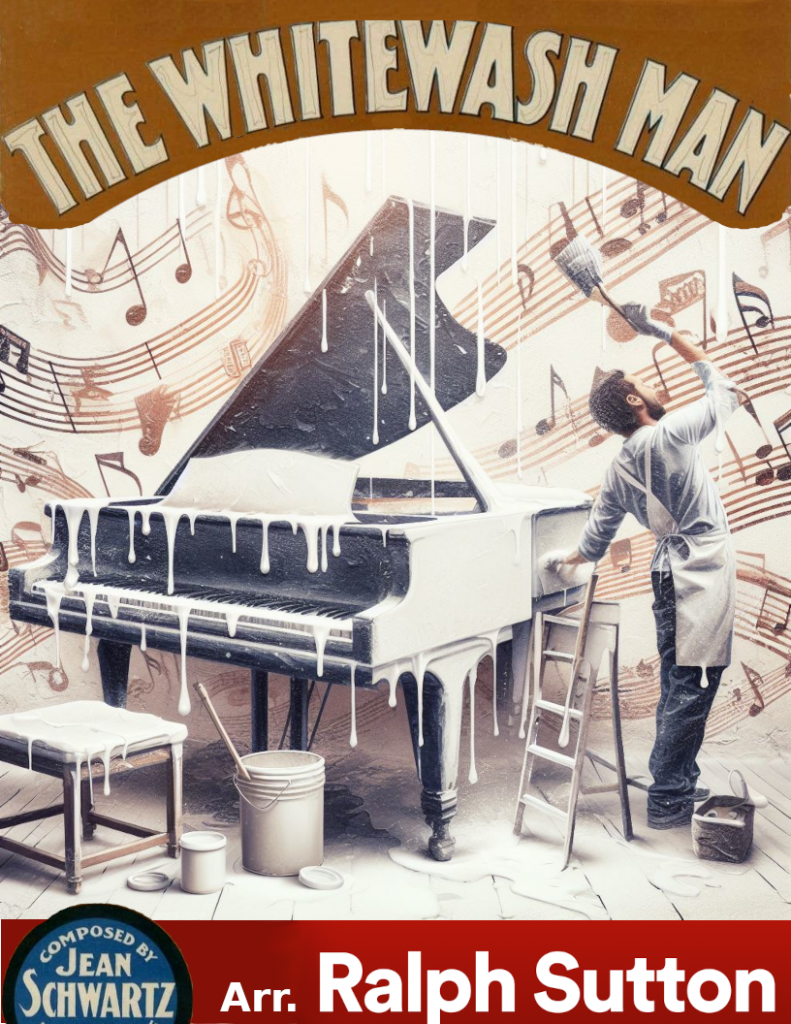
Now, the sheet music transcription:
Mr. Sutton’s tempo is an extremely fast 120 to the quarter note (duration 2:50). During the course of detailed analysis at very slow speeds, I never ran across anything that could be definitively be called a “mistake”. If there were any, they were perfectly integrated into the performance and are part of the transcription.
It was time for the 2019 West Coast Ragtime Festival. I felt motivated to compose another ragtime song. This one took a couple of weeks off and on, and plus a lot of minor edits ever since.
Here is a cover photo generated with the help of AI. [A gazorch is a large slingshot made of a bicycle innertube, often used to fire water balloons out of dormitory windows. You can use your imagination what this has to do with squirrels in the score!]
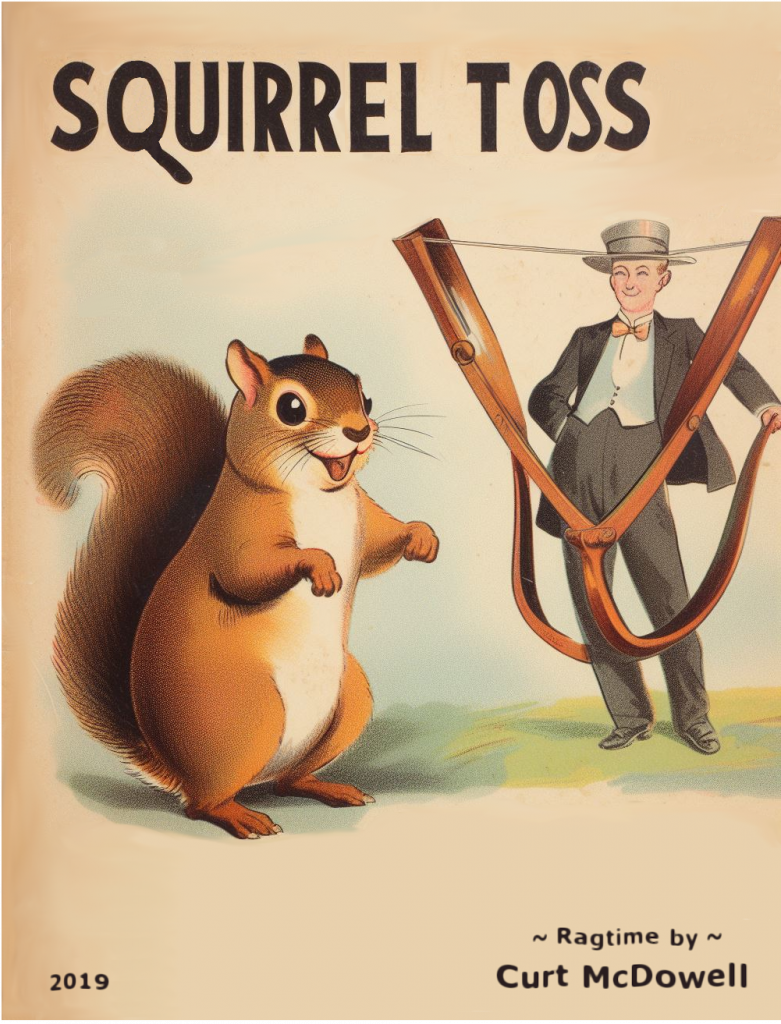
Here is the sheet music, which includes the cover photo.
The recommended tempo is 84 to the quarter note (duration 2:25).
For the first time, I attended the 3-day West Coast Ragtime Festival (2018) in Rancho Cordova, near Sacramento, California. It was about time, as I’ve been playing ragtime since high school and thinking about the festival for several years.
I spent about 3 solid days writing Sinky O, an original ragtime piece. I hoped to perform it during one of the few “open piano” sessions at the festival, which I did, but only a couple people were present and I did a lot of messing up.
There are some rough edges in the piece. The ending is sudden and the minor section is a little limited and repetitive. I may work on it some more.
The name is a play on the term “cinquillo,” which is one of three Spanish rhythms along with the tresillo and habanera. Cinquillo denotes a particular rhythm consisting of: 8th, 16th, 8th, 16th, 8th. Jelly Roll Morton’s works were influenced by Spanish music; he added what he referred to as the “Spanish Tinge”. Some ragtimes (e.g. Solace) were written using habanera.
Here is a cover sheet I designed using the help of generative AI and GIMP.
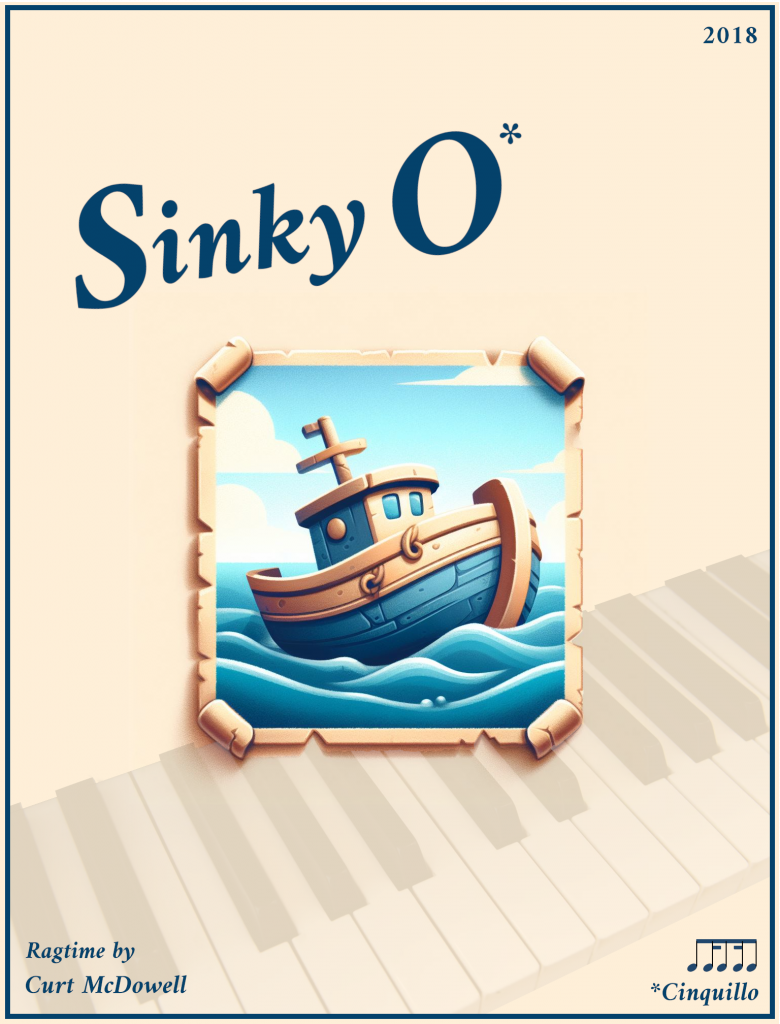
Here is a PDF of the score:
The recommended tempo is 200 to the 8th note (duration 3:00).
If you have not yet seen the original post about my Merry Go transcription for player piano, please read about it here.
The transcription was initially organized in four voices in the Lilypond source file. This made it relatively easy to direct Lilypond to write out a couple extra scores for a single-piano duet version. The two treble voices can be played by Primo, and the two bass voices by Secondo. This shows the power of Lilypond for maintaining multiple renditions from a single source file.
The duet was still not immediately playable. A few chords had too many notes and needed minor tweaks. The last 3 measures needed an alternate playable version; I think I struck a reasonable compromise by having the players alternate the fast final runs, and by reducing the 3-octave run to 2-octave. And in this version, the final chord does not contain all eight C keys on the piano!
As of this writing, the duet has not been performed by two people. I did record myself playing Secondo and then played Primo over it, but there may remain some awkward overlaps with two players on one piano.
If you’d like to print the 6-page duet in book form, I would recommend printing page 4 as simplex, pages 1 and 5 as duplex, pages 2 and 6 as duplex, and page 3 as simplex. Then you’ll be able to have Secondo on the left facing Primo on the right, for 3 pairs of pages. The page numbering is designed with this scheme in mind.